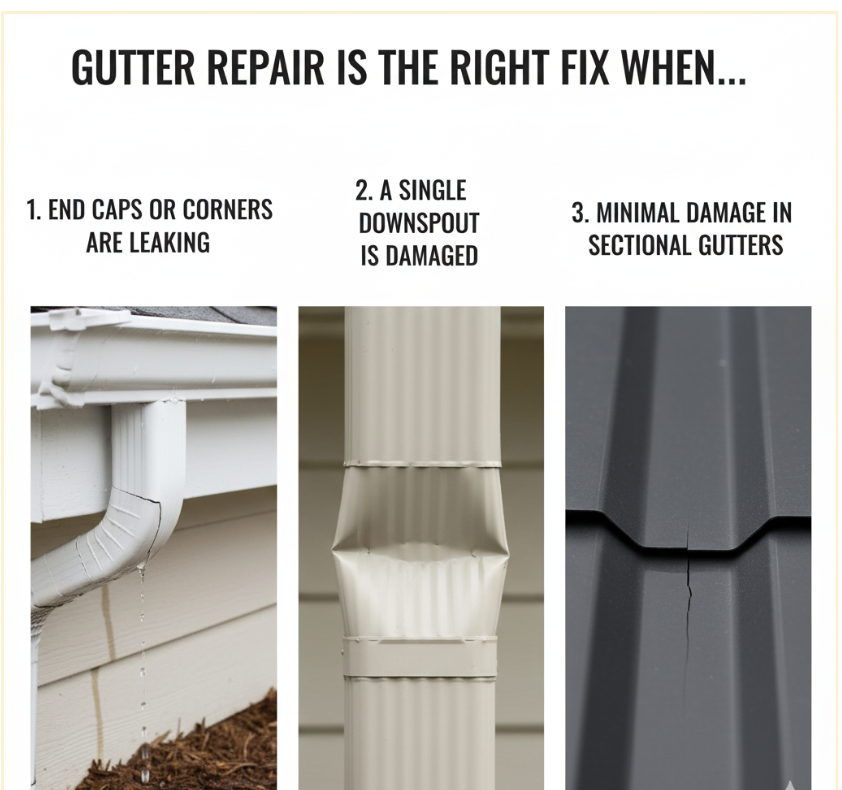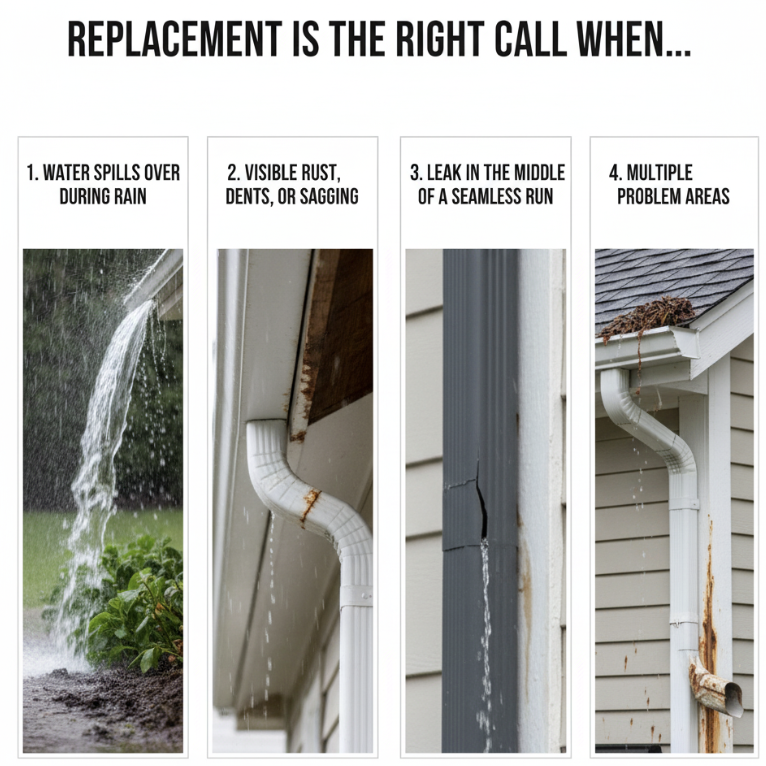What do you do when your gutter starts to fail? Is it as easy as a quick repair, or do you need a full gutter replacement?
The answer depends on the type of damage, the kind of gutters you have, and whether you want a quick fix or a long-term solution. At Hoel Roofing, we offer gutter installation, repair, and replacement services and have offered insight on what might be the best option for homeowners all across Indiana. We inspect the damage and provide an honest assessment, oftentimes saving homeowners in cases where a repair is necessary and in cases where a replacement can help prevent more damage to the roof.
In this article, we’ll discuss when a gutter repair may be the best choice and cases where a replacement is the best bet. We will also provide a cost comparison of repair and replacement, as well as the hidden costs of delayed action on your failing gutter. By the end of this article, you’ll know exactly which option is best suited for you.

Some problems don’t require ripping everything out. Repairs work best when:
The end caps (which close off the ends of your gutters) and corner joints (where two runs of gutter meet) are the most common leak points. If you notice a small drip where two gutters join, for instance, a trickle of water running down the siding during a storm, this is usually a simple fix. This can be fixed in a bit of time, usually with a sealant or a new connector.
Downspouts are the vertical pipes that carry water safely from your gutters to the ground. If one gets crushed (say, by a ladder or even a lawnmower), you don’t need to touch the rest of your system; the damaged piece can be swapped out quickly. A new downspout is relatively inexpensive compared to redoing gutters around the whole house.
With traditional sectional gutters, replacing one piece is possible. Traditional gutters are often made in shorter sections (usually 8-12 feet long) that snap or seal together. If damage is limited to just one piece, for example, a crack, bend, or hole in a single section, you can usually swap out only that piece instead of redoing the whole system. This makes sectional gutters cheaper to repair than seamless ones.
Overall, unless you are replacing a part of a gutter, these fixes are small, so much so that oftentimes when we come across them here at Hoel Roofing, we often reseal an end cap or tighten a bracket for free if we’re already on site. These little fixes don’t always need a big bill.
That said, a gutter repair is typically a temporary solution. With seamless gutters, especially, cutting out a section to replace it means introducing a seam, and seams are weak points that can fail again. Sectional gutters are more repair-friendly, but they come with tradeoffs. Each joint is a weak point that can eventually leak, especially in Indiana’s freeze-thaw cycles. So while replacement of one section is possible, keep in mind that the more joints you have, the more likely you’ll need future repairs.

Replacement is worth considering when repairs won’t last or when the system is failing as a whole. You may need new gutters if you notice:
If you notice water gushing over the edge of your gutters during a heavy rainstorm in Indiana, it’s a sign that your system can’t keep up. The gutters might be too narrow, clogged, or improperly pitched. In many cases, the only real solution is to replace them with wider gutters that can handle higher water volumes.
If you notice water spilling over during rain, it is important that you look into replacing the gutter as soon as possible. This is because overflowing gutters don’t just waste water; they dump it directly near your foundation, leading to basement leaks, soil erosion, or even foundation cracks over time. Upgrading to the right size gutter ensures water is safely directed away from your home.
Like everything else, gutters age; typical signs of aging are rust spots, noticeable dents from hail, or sections sagging away from the fascia. These are signs of structural weakness, and patching won’t restore their strength.
Sagging gutters can even pull on your fascia boards and cause roofline damage. Replacing them stops small issues from becoming roof and siding repairs later.
A seamless run is a single, continuous stretch of gutter custom-cut to fit the exact length of your roofline, no joints or connectors along the way. Seamless gutters are built as one continuous piece for a reason: fewer seams mean fewer leaks. But if a hole or crack develops in the middle of a run, the only way to repair it is by cutting and adding a seam, which undermines the whole point of seamless design. Once you compromise the seamless system, you’ve introduced a weak point that can leak again in the future. So, we never cut a section. Replacing the entire run is the smarter, longer-lasting investment.
If you’ve got more than just one or two trouble spots, say, three leaks, a sagging section, and a broken downspout, repair costs start to add up quickly. At that point, replacing the whole system is usually more cost-effective than chasing problems one by one.
Spending money on repeated small fixes may seem cheaper in the moment, but the costs add up quickly. A complete replacement often gives you a fresh warranty and many more years of peace of mind, making it the better long-term value.
Tip: Repairs might feel cheaper upfront, but repeated patchwork adds up. A one-time replacement often saves money in the long run.
Gutters might not be the flashiest feature of your home, but they’re one of the most critical. They protect everything downstream, your roof, siding, basement, foundation, and even your yard. The trouble is, once gutters fail, water damage can begin in as little as one or two heavy rains. Minor leaks or sagging should be repaired within weeks, and if your gutters are cracked, pulling away, or overflowing regularly, replacement shouldn’t be delayed more than a season. Putting off action not only multiplies the damage but also drives up repair costs dramatically. Some costs that can start piling up quickly are:
With gutters, the sooner you take action when damage occurs, the better protected your house will be.
In states like Indiana, gutters are more important than homeowners realize. Two main factors put extra stress on them:
Your home shouldn’t have to fight Indiana weather alone. A strong gutter system makes all the difference.
| Situation | Repair Makes Sense | Replacement Makes Sense |
| Small leak at the end cap | ✅ | |
| Crushed downspout | ✅ | |
| Leak in the middle of a seamless run | ✅ | |
| Multiple problem areas | ✅ | |
| Overflow during rain | ✅ (wider gutters) | |
| Visible sag, rust, or dents | ✅ |
If your gutters have one or two small issues, repair might carry you through another season. But if you’re seeing leaks, overflow, or multiple trouble spots, replacement is the smarter long-term investment.
At Hoel Roofing, we don’t just slap on patchwork fixes; we help homeowners choose the option that actually protects their home for the long haul. We’re happy to inspect your gutters and give you an answer on what they really need. Schedule your free gutter inspection today and know for sure whether repair or replacement is right.
Toyosi Ogunsola is the Content Manager at Hoel Roofing & Remodeling in Rushville, IN, where she oversees the creation of educational, trustworthy content about roofing, remodeling, and home improvement. With a master’s degree in Emerging Media Design and Development and a background spanning content strategy, UX research, and digital marketing, Toyosi combines data-driven insights with clear, engaging writing to help homeowners make informed decisions. Passionate about translating complex roofing topics into helpful resources, she works closely with Hoel’s team of roofing experts to ensure every piece of content is accurate, practical, and user-focused.